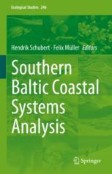Search
Search Results
-
How free-floating macrophytes influence interactions between planktivorous fish and zooplankton in tropical environments? An in-lake mesocosm approach
In tropical climates, free-floating aquatic plants may dominate shallow lakes and affect trophic interactions between zooplankton and their predators...

-
Mechanisms of Ecosystem Service Production: An Outcome of Ecosystem Functions and Ecological Integrity in Coastal Lagoons
Coastal lagoons provide important ecosystem services, but are simultaneously highly vulnerable. We aim at a better understanding of the mechanisms of...
-
Effects of shining pondweed (Potamogeton lucens) on fungal communities in water and rhizosphere sediments in Nansi Lake, China
Submerged macrophytes play an important role in structuring biological communities. Aquatic fungi are an important component of aquatic ecosystems....

-
How do substrate types affect the seasonal richness and functional feeding groups variation of benthic insects in an arid region (northeastern Algeria)?
The diversity of bottom substrates is a primary driver of taxonomic richness and species abundance patterns of freshwater benthic insects in space...

-
Efficiency of Aquatic Plants for Remediation of Wastewater
Rampant industrialization, unplanned urbanization, and agricultural activities release an enormous quantity of contaminants in water which adversely...
-
Role of Macrophytes in Spontaneous Lacustrine Phytofiltration
Macrophytes execute optimization and self-purification tasks; else, the apparent water quality can become inferior. They work as a living link amid...
-
Morpho-functional traits of phytoplankton functional groups: a review
This paper reviews more than 40 journal articles that describe the traits of phytoplankton functional groups (FGs) and their responses to biotic and...

-
Applications of Macrophytes as Environmentally Sound Technique for Cleaning of Contaminated Ecosystems
Water is an important resource that supports life on the earth. Contamination with diverse categories of pollutants (toxic metals, agrochemicals,...
-
Seasonal and diurnal patterns of littoral microhabitat use by fish in gravel pit lakes, with special reference to supplemented deadwood brush piles
The habitat quality of the littoral zone is of key importance for almost all lentic fish species. In anthropogenically created gravel pit lakes, the...

-
Use of Euclidean distance to evaluate Pistia stratiotes and Eichhornia crassipes as organic fertilizer amendments in Capsicum annuum
Conventional agriculture is reliant on the application of unsustainably high rates of inorganic fertilizers with detrimental consequences on the...

-
Structure of the Macrophyte Communities of Small Rivers in Saratov under Anthropogenic Load
Abstract —The results of investigations of the flora of small rivers within the city of Saratov (Elshanka, Nazarovka, Pervaya Gusel’ka, and Vtoraya...

-
Invasive submerged macrophytes complicate management of a shallow boreal lake: a 42-year history of monitoring and restoration attempts in Littoistenjärvi, SW Finland
The small, shallow lake Littoistenjärvi (SW Finland) experienced in 1978–2019 rapid fluctuations between extreme ecological states, initially...

-
Ecosystem bioelement variability is associated with freshwater animal aggregations at the aquatic-terrestrial interface
The impacts of animals on the biogeochemical cycles of major bioelements like C, N, and P are well-studied across ecosystem types. However, more than...

-
What are the main environmental predictors of differences in the community structure of periphytic desmids in a semi-arid floodplain lake?
The desmids constitute a highly diverse group with potential as a bioindicator of the conservation status of freshwater environments. We evaluated...

-
Do the snail (Filopaludina bengalensis) and mussel (Lamellidens marginalis) vary in bioturbation effects? Inference from the changes in water quality and producers
The freshwater snails and mussels are recognized as ecosystem engineers owing to their ability to influence the ecological processes. We investigated...

-
Sandy beach wrack as a resource: nutrient quality explains amphipod preferences but not temporal variation
Sandy beach invertebrates depend largely upon allochthonous inputs of macrophytes and the oceanographic processes that deliver them as wrack. While...

-
Assessment of cardinal temperatures of Egeria najas Planchon and its potential growth in a tropical floodplain lagoon
Knowledge of the factors controlling the growth of macrophytes is essential to forecasting their spatial distribution and management. Based on growth...

-
Microhabitat associated macrofauna of lotic and lentic systems in the Agbede wetlands, southern Nigeria
Although studies on the macrofauna of lotic and lentic environments are common, investigations on microhabitat associated macrofauna of lotic and...

-
Climate change, salinity variations and their impacts on ecosystem structure: a mesocosm experiment with a Pampean drought and flood frame
Climate change scenarios for sub-humid and semi-arid regions predict that current cycles of drought and flood will intensify. In shallow lakes, that...

-
Anthropogenic activities and habitat complexity influence fish functional diversity in a Neotropical reservoir
Reservoir shorelines are usually colonized by submerged macrophytes, which may select fish species that are able to thrive in these environments,...

